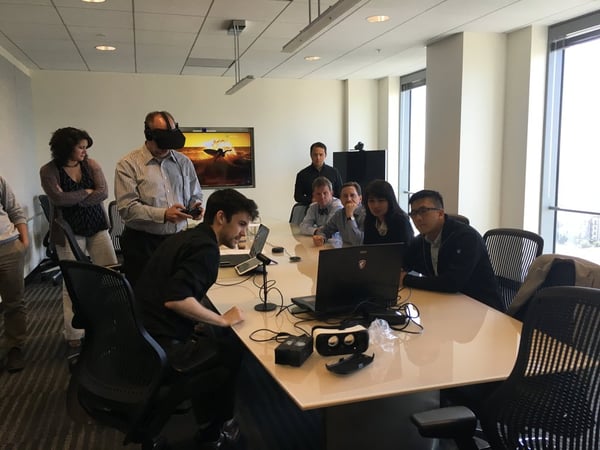The Rapidly-Evolving World of VR
A lot has changed in the virtual reality hardware landscape in the last nine months. Not only have we seen the commercial release of the Oculus Rift and HTC Vive headsets, but graphics card manufacturers have also continued to push the limits of what’s possible in VR with increasingly powerful Graphics Processing Units (GPUs). The GPU is the most important single piece of hardware for running a desktop VR experience. Powerful GPUs are continuing to drop in price, and are more readily available. Today many more PC manufacturers realize the importance of supporting VR experiences, both for consumers and enterprise users, and specs on top-of-the-line machines are starting to reflect the needs of VR users.
The Latest and Greatest GPUs
If you’ve been running Prospect on an Nvidia GTX 960 or even an older GPU, you might not be getting the most out of the latest features in Prospect. The Nvidia GTX 1080 is the current flagship VR GPU and is our personal favorite* for testing and demoing IrisVR Prospect. It simply blows away other GPUs in benchmark testing and in terms of user experience. On a GTX 1080, Prospect runs with blazingly-high frame rates, even in complex models with high polygon counts. This allows for the most seamless, realistic experiences whether you’re using Prospect for usability studies, client demonstrations, or immersive design reviews.
*Our recommendation as of post date. What's best in VR hardware changes quickly, so we always recommend users do their research before investing in VR computers and headsets.
Availability
The Nvidia GTX 1080 is available in a number of desktops and laptops, many of which are priced comparably to a typical high-powered enterprise workstation. For top-of the line performance in a (relatively) portable package, the MSI GT73VR laptop is the standout choice. Though not exactly lightweight at 8.5 pounds, its 2.7GHz i7 processor, 32GB of RAM, and SSD + HDD combo give users the resources to power any and all VR and modeling needs. It’s available on Amazon or via one of MSI’s resellers. For users running VR in a dedicated space at the office or site, where portability is less crucial, the MSI Nightblade MI2 is a blazing-fast desktop, and a top pick for those who want to get the most out of their VR investment.
“Having a portable VR laptop reduces the barriers to using VR for meetings outside your office. A few weeks ago in Los Angeles, I ran our software at a construction site!”
- Shane Scranton, IrisVR CEO
 Shane showing off VR's portability (though not at a construction site). Photo Credit: TCA Architecture.
Shane showing off VR's portability (though not at a construction site). Photo Credit: TCA Architecture.
Test Your System
Think your current system might not be up to spec? Download the Oculus Hardware Check Tool or the HTC Vive Performance Tester. Remember that Prospect publishes slightly different minimum requirements than HTC or Oculus, so make sure to check the results of these tools against our minimums here: Prospect Minimum Requirements.
Love your hardware? Have tips on how to get the most out of your setups? Share on the forums or drop us a line about it. We always love feedback from our users.
Note: We sometimes use Amazon Associates links in our blog posts to help understand our readers better. For more on that, see our explanation here.
.png?width=212&name=Prospect%20by%20IrisVR%20Black%20(1).png)
